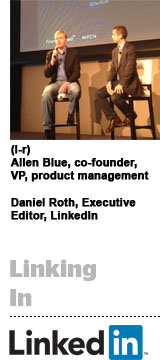 Professional social platform LinkedIn is cooking up a number of paid product extensions, at the base of which is its nearly 300 million-member-strong social graph and a quickly growing content operation.
Professional social platform LinkedIn is cooking up a number of paid product extensions, at the base of which is its nearly 300 million-member-strong social graph and a quickly growing content operation.
At LinkedIn’s FinanceConnect in New York Thursday, an event that drew roughly 200 marketers, financial professionals, customers and partners to the Time Warner Center despite the wintry whiteout conditions, LinkedIn VP of Product David Thacker outlined 2014 goals for the company’s marketing solutions.
One of the top priorities, he said, is developing a retargeting tool to tap into LinkedIn’s “powerful” datasets. Additionally, based on insights derived from the platform’s algorithms and machine-learning capabilities, LinkedIn cited plans to enable lookalike modeling later this year to help advertisers extend their reach beyond current customers.
Thacker also mentioned a pilot program showcasing content trending across LinkedIn’s entire member base, and the testing of an attribution capability through which marketers can determine the extent to which their spend drives ROI.
The end goal for LinkedIn, Thacker said, is to streamline the overall user experience while also providing helpful ways to manage and promote content for marketers. Plans to develop lead-capturing capabilities “have the most potential to be disruptive, particularly for the mobile use case specifically,” Thacker said. “It’s hard to fill out a lead form on a mobile device.”
The focus on mobile is intentional. Forty-one percent of LinkedIn’s traffic came from mobile during Q4, which spurred investment in this area. Much of the development will focus on the LinkedIn feed in order to promote content consumption.
“We wanted LinkedIn to be a mechanism to filter information that would ‘flow to me through my network that could be good for me’ and we think of content as a natural extension of a social network,” said Allen Blue, LinkedIn’s co-founder and VP of product management. “People turn to information from publishers and Google to help them make better decisions. We want to build up a data resource to help us all make better decisions.”
Curiously, LinkedIn’s movements, which include Groups, an Influencer program, Showcase Pages (launched in November as an extension of Company Pages) and Sponsored Updates, almost mimic Twitter and Facebook’s monetization march.
This is also evident when one examines how LinkedIn’s tools are designed to provide more paid media opportunities for marketers based on real-time information through trending content. The company introduced self-serve native ad units last year and already has an ads API; CEO Jeff Weiner has also spoken of enabling programmatic-buying abilities for ad purchases.
And just as Facebook coined the “social graph,” LinkedIn wants to build “an economic graph” of the world’s employees, employers, jobs and skill sets. LinkedIn’s revenues are still, for the most part, derived from recruiting tools via Talent Solutions (this accounts for 55% of business, per LinkedIn’s latest earnings call). However, about 25% of revenues, or $113 million in Q4, came from Marketing Solutions, a slight slip from the 27% in 2012.












